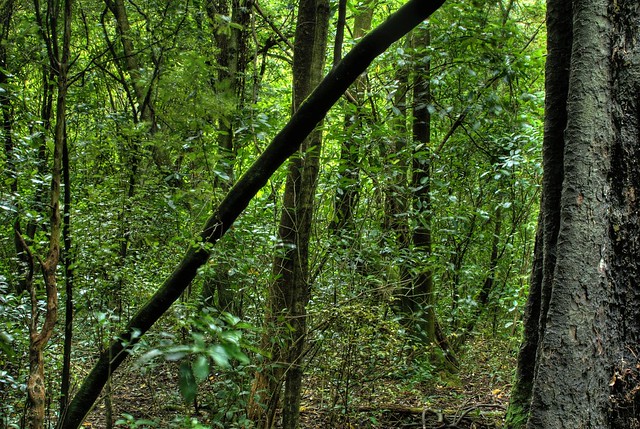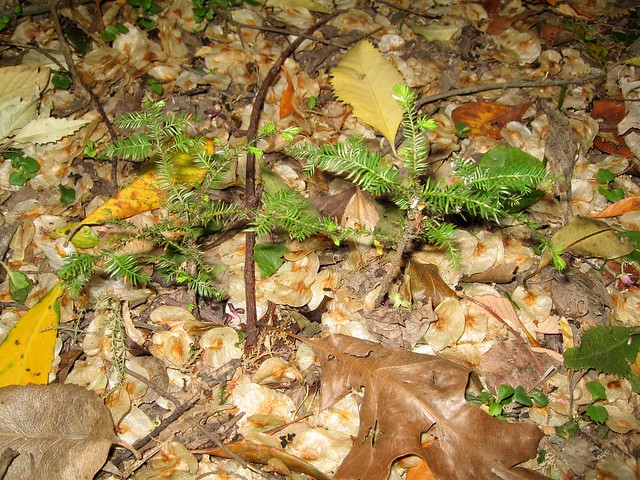RECENT ARTICLES
- CEBRA: An optimised and standardised sampling protocol for BioBlitz
- Stop it people, the plural of anecdote IS data!
- That's no pollinator, that's a flower visitor
- Add a scale to your macro photos
- What to photograph when counting the wild
- Imagine counting the wild on EVERY street in a city!
- My wild counting workflow
- A butterfly flew through
- Why iNaturalist observations without photos can be research grade
- Why you shouldn’t use a spreadsheet for data entry
- All articles ...
A kahikatea in the head is worth two in the bush
Wild forests are just a wall of green to most people, which is a shame, because forests are a wild tangle of amazing stories if you know the species.
written Jan 15, 2014 • by Jon Sullivan • Category: Wild Soapbox

In last week’s blog post, I introduced the results of my annual survey of university student knowledge of New Zealand natural history. Students arriving at Lincoln University are a lot less familiar with New Zealand plant and animal species than I’d expected. That includes not knowing which are native and which are introduced.
This reminded me of a related study I was involved with a few years ago led by then MSc student Brendan Doody (now on a Commonwealth scholarship doing his PhD at Durham University). Brendan did a combined social science and ecology study at Lincoln University on Christchurch’s old growth forest remnant, Riccarton Bush, and how it interacts with the suburban gardens and gardeners that live around it.

Small fragments of habitat like Riccarton Bush (at 7.8 ha) are too small to sustain all their species in the long term (without ongoing active management) and the forest has lost about a third of its plant species in the 125 years since European settlement. It would be good for the ecological integrity of the bush if some of the native plants in the forest could expand their wild populations out into the surrounding suburban gardens. Bigger populations are more robust.
Brendan spent his M.Sc. thesis seeing to what extent this was already happening, and was there potential for more of it. There’s a nice summary of Brendan’s findings over on the Lincoln University Ecology Department’s EcoLincNZ blog. In short, tree species from Riccarton Bush were being dispersed by birds out into the surrounding gardens, especially those gardens closer to the bush, but gardeners were then pulling them out.
Only 2% of gardeners living near Riccarton Bush could identify a seedling of kahikatea, the dominant canopy tree in the bush.
Clearly people don’t want a big tree coming up in the middle of their veggie garden. Through Brendan’s surveys it was clear that some seedlings coming from Riccarton Bush parents were pulled out from gardens because they were unlucky enough to land in an unsuitable place in the garden. 65% of people surveyed said they would remove all self-introduced woody plants on their property with a further 13% removing them from at least one area of garden.
What surprised us though was the inability of most Riccarton gardeners to identify the common species in Riccarton Bush. As part of his survey, Brendan showed gardeners a live seedling of kahikatea (Dacrycarpus dacrydioides), the dominant canopy tree in Riccarton Bush. Only 2% of people correctly identified it to species, with a further 3% naming it amongst other species they thought it might be. 33% knew it was some kind of conifer, including 11% that thought it was a tōtara, another NZ native conifer. 28% had no idea at all.

Brendan also asked people to say whether each of a list of 16 tree species “were in New Zealand before people arrived”. They could say yes, no, or be not sure. We chose a selection of common species from Riccarton Bush and from Christchurch gardens and parks, and listed them by the English common name and scientific name. Here are the results of the 85 surveys, taken from Brendan’s thesis.
| Common/(Species Name) | % Correct | % Incorrect | % Not sure |
| Native New Zealand species (all present in Riccarton Bush) | |||
| Cabbage tree (Cordyline australis) | 81 | 11 | 8 |
| Kahikatea/white pine (Dacrycarpus dacrydioides) | 76 | 7 | 16 |
| Lemonwood (tarata, Pittosporum eugenioides) | 60 | 14 | 26 |
| Lancewood (horoeka, (Pseudopanax crassifolius) | 49 | 12 | 39 |
| Broadleaf (kapuka, Griselinia littoralis) | 38 | 18 | 45 |
| Wineberry (makomako, Aristotelia serrata) | 22 | 22 | 55 |
| Marbleleaf (putaputaweta, Carpodetus serratus) | 15 | 25 | 60 |
| Milk tree (turepo, Streblus heterophyllus) | 5 | 33 | 62 |
| Naturalised introduced species (all present in Christchurch parks and gardens) | |||
| Radiata pine (Pinus radiata) | 71 | 18 | 12 |
| Cedar Elm (Ulmus crassifolia) | 66 | 8 | 26 |
| Common oak (Quercus robur) | 65 | 19 | 16 |
| Sycamore (Acer pseudoplatanus) | 62 | 15 | 22 |
| Elder/Elderberry (Sambucus nigra) | 60 | 16 | 24 |
| Macrocarpa (Cupressus macrocarpa) | 54 | 29 | 16 |
| Crack Willow (Salix × fragilis) | 51 | 11 | 39 |
| Rowan (Sorbus aucuparia) | 47 | 6 | 47 |
While hardly anyone could identify a kahikatea seedling when shown it, most still knew that it was a native species, quite possibly because of its Māori common name. That was more the exception than the rule though. We were surprised that even iconic native species like lancewood and broadleaf were not commonly known to be native species. Similarly, only about half of people knew that iconic exotic trees like macrocarpa and the weed crack willow are not native to New Zealand. Just like my student survey, Brendan’s results suggest that most New Zealanders have a limited awareness of the species around them and their natural history. Riccarton Bush must be a wall of leafy green texture to most people.
Despite this limited knowledge, support for Riccarton Bush was high. Over 95% of people agreed that Riccarton Bush was an asset to Christchurch and over 90% disagreed with the statement “The future of Riccarton Bush is not important to me”. 78% of people even thought that “The expansion of Riccarton Bush is a good thing”. About half of people agreed with the statements “I would be prepared to plant Riccarton Bush species in my garden” (54%) and “I would be prepared to let self-introduced Riccarton Bush plants become a permanent part of my garden” (47%). Some would be happy to transplant wild seedlings of species they wanted to suitable areas of their garden.
Brendan’s work underscores the awkward disconnect between New Zealanders’ conservation ethic and conservation knowledge. We New Zealanders are typically supportive of conservation, especially in national parks, but few of us appreciate the full extent to which we now live and work in landscapes dominated by introduced species, both cultivated and wild.
In Brendan’s study, half of gardeners around Riccarton Bush said they would let some self-introduced wild plants from the bush grow up in their gardens, and Brendan found that many species were being dispersed by birds out into surrounding gardens and germinating. Yet gardeners were then pulling them out because they didn’t recognise them and appreciate their importance. Because of this, the native plant community of Riccarton Bush remains small and isolated and vulnerable. A kahikatea in the head really is worth two in the bush.
Doody, B. J., Sullivan, J. J., Meurk, C. D., Stewart, G. H., and Perkins, H. C. 2010. Urban realities: the contribution of residential gardens to the conservation of urban forest remnants. Biodiversity and Conservation, 19:1385–1400.